Top 15 birds with long beaks, Birds are truly fascinating creatures, with their multitude of characteristics and adaptations, birds are truly fascinating creatures. Among the many notable features that distinguish different species of birds, the shape and size of their beaks play a key role in their survival and behavior. The long beak is a unique adaptation that allows some birds to reach into crevices, extract nectar from low-lying flowers, or catch fish with precision. In this article, we take a look at the top 15 long-beaked birds, highlighting their unique characteristics and the benefits their beaks offer.
1. Dalmatian Pelican (Pelecanus crispus):
The Dalmatian Pelican (Pelecanus crispus) is a magnificent and imposing waterbird that commands attention with its massive size and striking appearance. Known as the largest member of the pelican family, this avian species stands out not only for its size but also for its unique plumage and remarkable behavior.
Endemic to the Balkans and certain regions of Asia, the Dalmatian Pelican holds a special place in the hearts of bird enthusiasts and conservationists alike. In this article, we will explore the fascinating characteristics, habitat, behavior, and conservation efforts surrounding this magnificent bird.
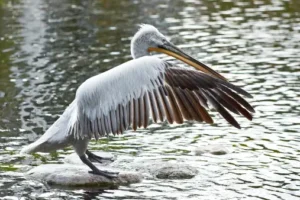
Where they are found: Typically found in temperate regions, they are found in various parts of Europe and Asia, including the Balkans, parts of the Mediterranean, and parts of Russia and Central Asia.
Beak length: 36-45 cm or 14 -18 inch
Diet: They are skilled fishermen and use their massive pouch-like beaks to catch fish, primarily carp and other freshwater species. The pelicans often cooperate during group feeding, corralling fish into shallow areas for easier capture.
2. Rhinoceros Hornbill (Buceros rhinoceros):
The hornbill (Buceros rhinoceros) is a beautiful and charismatic species of bird that lives in the lush rainforests of Southeast Asia. Thanks to its impressive size, unique helmet and distinctive vocalizations, this bird wonder has earned a special place in the folklore and culture of the region.
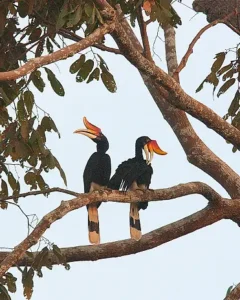
As the dominant species in its habitat, the hornbill plays an important role in the ecosystem a
s a seed disperser and contributes significantly to forest regeneration. In this article, we examine the intriguing traits, habitats, behaviors, and conservation efforts surrounding this formidable bird.
Where they are found: They are found in the lowlands and in the mountains, in tropical and subtropical climate zones and in mountain rainforests up to 1,400 meters in height on Borneo, Sumatra, Java, the Malay Peninsula, Singapore and southern Thailand.
Beak length: 23-28 cm or 9-11 inch
Diet: The Rhinoceros Hornbill’s diet consists mainly of fruits and figs, playing a vital role in seed dispersal within the rainforests.
3. Stork Birds With Long Beaks:
It is a well-known and easily recognized species by its distinctive white plumage, long red legs, and long, pointed beak. This bird is widespread in Europe, parts of Asia and Africa. It is also one of the most well-known stork species to people around the world due to its habit of nesting on rooftops and other man-made structures.
White Storks are known for their impressive migratory behavior. They undertake long-distance migrations between their breeding and wintering grounds. Many White Storks from Europe migrate to Africa during the winter months to escape the colder climates, while some populations in Asia may remain in their breeding areas throughout the year.
![]()
Where they are found: This bird is widespread in Europe, parts of Asia and Africa
Beak length: 100–115 cm 39–45 inch
Diet: The White Stork primarily feeds on a diet of small vertebrates, including insects, frogs, fish, small mammals, and sometimes even snakes. They forage in wetlands, grasslands, and agricultural fields.
4. Kiwi (Aptery) Birds With Long Beaks:
There are several species of Kiwi, each with slightly different characteristics, but they all share similar features. One of the most distinctive traits of Kiwis is their long beak, which they use to probe and sniff the ground in search of insects and other invertebrates, as they are primarily nocturnal and carnivorous.
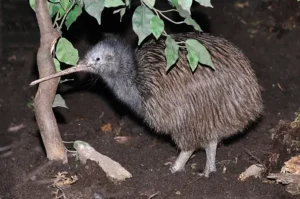
Where they are found: The Kiwi is a flightless bird native to New Zealand and is a member of the Apterygidae family
Beak length: 8-10 cm or 4-8 inch
Diet: Kiwis are omnivorous and will feed on a variety of insects, worms, fruits, seeds, earthworms and plants.
5. Shoebill Birds With Long Beaks:
The shoebill (Balaeniceps rex) is an adorable and distinctive bird known for its large, shoe-shaped beak, hence its name. Shoebirds are solitary animals that tend to remain silent for long periods, which helps them blend in with their surroundings and patiently await prey.
Butobill is classified as “Vulnerable” by the International Union for Conservation of Nature (IUCN). Their population is declining because of habitat loss due to human activities such as wetland drainage and nest site destruction. In addition, they are threatened by hunting and human disturbance of their breeding grounds.
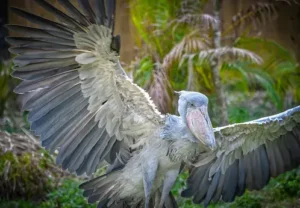
Where they are found: Also referred to as the “whale-headed stork” or “shoebill stork,” this remarkable species is found in the swamps and wetlands of central tropical Africa.
Beak length: The Shoebill uses its beak as a defense mechanism against potential threats because it is 9 inch long and 4 inch wide.
Diet: Although less common, they may also eat small mammals such as rodents or young mammals found near the water’s edge. They also eat fish, birds, snakes and lizards.
Must Visit: Parvo Virus
6. Toco Toucan (Ramphastos toco):
The Toco Toucan (Ramphastos toco) is a large and striking bird species belonging to the toucan family, Ramphastidae. It is one of the most recognizable toucan species due to its vibrant colors and impressive beak.
Overall, the Toco Toucan is a fascinating and captivating bird species, known for its distinctive appearance and lively behavior, making it a favorite among birdwatchers and wildlife enthusiasts.
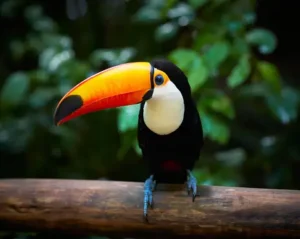
Where they are found: They can be found in the eastern and central regions of South America, with Brazil being one of the primary countries where Toco Toucans are commonly seen.
Beak length: 15 to 20 cm 6 -8 inch
Diet: Toco Toucan (Ramphastos toco) eat fruits and insects and seeds.
7. Bald Eagle (Haliaeetus leucocephalus):
The Bald Eagle (Haliaeetus leucocephalus) is a majestic bird of prey and the national bird and symbol of the United States of America. It is one of North America’s most recognizable and iconic birds. Here are some key facts about the Bald Eagle.

Where they are found: They can be found in many parts of the United States and Canada. Bald Eagles are distributed across a wide range of habitats, including coastal areas, lakes, rivers, marshes, and large open bodies of water.
Beak length: It has a powerful beak around 7-9 inch.
Diet: Depend on availability and location but it eats fish, variety of birds, small mammals, waterfowl and rabbits.
8. Lesser Flamingo (Phoeniconaias minor):
Flamingos are large aquatic birds known for their distinctive pink coloring, long legs, and long neck. The Lesser Flamingo is one of five species of flamingo and the smallest and most widespread of them all.
They do not have the sense of taste or spell, therefore they use their eyesight. Lesser Flam
![]()
ingos are highly social birds, often forming large colonies that can include thousands or even millions of individuals.
These colonies are essential for protection against predators and for successful breeding. The females lay a single chalky-white egg on a mud nest built in shallow water, and both parents take turns incubating the egg.
Where they are found: The Lesser Flamingo (Phoeniconaias minor) is found in various parts of sub-Saharan Africa and northwestern India. They are highly gregarious birds and are known for their spectacular large flocks.
Beak length: The average beak length of a Lesser Flamingo (Phoeniconaias minor) is around 10-12 cm (approximately 4-4.7 inches).
Diet: In addition to blue-green algae, Lesser Flamingos may also feed on other types of algae, diatoms, small crustaceans, and aquatic invertebrates that are found in their preferred feeding areas, which are usually shallow saline or alkaline lakes, mudflats, and lagoons.
9. Australian Pelican Birds With Long Beaks:
The Australian Pelican has a predominantly white plumage with black feathers on its wings. Its long, broad bill is one of its distinguishing features. The bill has a large throat pouch that can hold a substantial amount of fish or water when foraging. During the breeding season, the pelican’s bill and pouch turn a vibrant pinkish color, which is an indication of their readiness to mate.
They are social birds and are often seen in large flocks, especially when fishing or roosting. Pelicans are excellent fliers and can soar at great heights, gliding on thermal air currents for long distances. When hunting for food, they employ a distinctive “plunge-diving” technique, diving from the air to catch fish near the water’s surface.
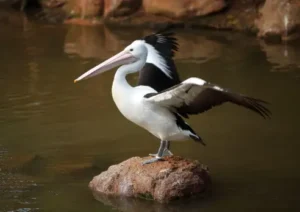
Where they are found: The Australian Pelican (Pelecanus conspicillatus) is a large waterbird found throughout Australia, including its surrounding islands and coastal areas.
Beak length: 40-50 cm or 15.7-19.7 inch.
Diet: They primarily feed on small to medium-sized fish but can also consume crustaceans and occasionally take small birds or other aquatic animals.
10. Woodpecker Birds With Long Beaks:
Woodpeckers (Picidae) are a family of birds that belong to the order Piciformes. They are well-known for their unique behavior of pecking on trees and other wooden surfaces to find insects, excavate nesting holes, and communicate with each other.
Woodpeckers have strong, chisel-like beaks that are specially adapted for drilling into wood. They use their beaks to create holes in trees to find insects, larvae, and sap, which form a significant part of their diet. Woodpeckers face various threats, including habitat loss, deforestation, and urbanization.
Some species have been affected by human activities that lead to the destruction of their nesting and foraging sites. However, many woodpecker populations are stable, and some have adapted well to human-altered landscapes.
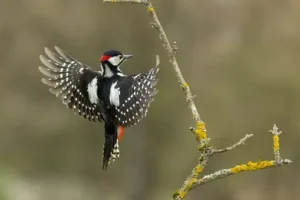
Where they are found: Woodpeckers (Picidae) are found in various regions across the world, except for Australia, New Guinea, and Madagascar. They inhabit a wide range of habitats, including forests, woodlands, savannas, grasslands, and even urban areas with sufficient trees.
Beak length: 3.8-6.4 cm or 1.5-2.5 inch.
Diet: Their primary diet consists of insects, especially wood-boring beetles, ants, and other invertebrates. Some species may also consume fruits, nuts, and seeds.
Must Visit: Why Grooming is essential for Pets
11. Sword-Billed Hummingbird (Ensifera vinifera):
This specialized bill is adapted for reaching deep into tubular flowers to access nectar that other hummingbird species may not be able to reach.
Apart from their long bill, they have iridescent green plumage on their upperparts and a white or pale underbelly. Males and females look similar, with the males being slightly larger in some cases.
Like other hummingbirds, they are highly energetic and agile fliers, capable of hovering in mid-air by flapping their wings rapidly. They are territorial and can be aggressive in defending their feeding areas.
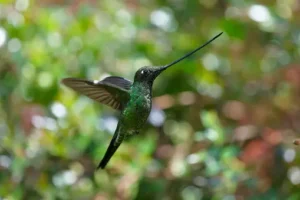
Where they are found: It is found in the Andean regions of South America, Sword-Billed Hummingbirds are primarily found in high-altitude montane forests, cloud forests, and shrublands in the Andes mountains of South America. They are known to inhabit countries such as Colombia, Ecuador, Peru, Bolivia, Venezuela, and parts of northern Chile and Argentina.
Beak length: The beak length of a Sword-Billed Hummingbird can measure up to 10 cm about 4 inches in length.
Diet: The Sword-Billed Hummingbird mainly feeds on nectar from a variety of flowering plants. Their long bills allow them to access nectar from long tubular flowers that are not easily accessible to other birds.
12. Keel-Billed Toucan (Ramphastos sulfuratus):
The most prominent feature of the Keel-billed Toucan is its large and colorful bill, which is primarily yellow and orange with a greenish-blue base and red tip.
The toucan has a black plumage with a bright yellow throat and chest. It has blue feet and a red under tail. Keel-billed Toucans are highly social birds and are often seen in small groups or pairs.
They are known for their loud, croaking calls, which they use to communicate with each other. These beautiful birds are often seen in zoos and wildlife sanctuaries, where they are admired for their distinctive appearance and playful behavior. However, it’s important to protect their natural habitats to ensure their survival in the wild.
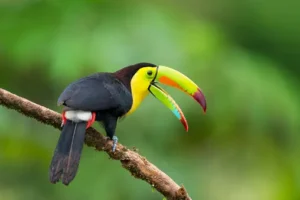
Where they are found: The Keel-billed Toucan, scientifically known as Ramphastos sulfuratus, is a colorful and striking species of toucan found in parts of Central and South America. It is also referred to as the Rainbow-billed Toucan due to its vibrant and distinctive bill.
Beak length: The overall body length ranges from 17 to 22 inches (43 to 55 cm), and they weigh around 380 to 500 grams.
Diet: The diet of Keel-billed Toucans primarily consists of fruits such as figs, berries, and various other types of tropical fruits. Additionally, they may also eat insects, small reptiles, eggs, and nestlings on occasion.
13. American Avocet (Recurvirostra Americana):
The American Avocet has a striking black and white plumage with a distinct reddish-brown head and neck during the breeding season. Its back and wings are black, while the underparts are white.
Outside of the breeding season, the plumage is more subdued, with a grayish-brown tone. During the breeding season, which typically occurs in late spring and summer, American Avocets build their nests on the ground near water.
They often nest in colonies, alongside other water birds. The female lays a clutch of 3 to 4 eggs, which both parents take turns incubating.
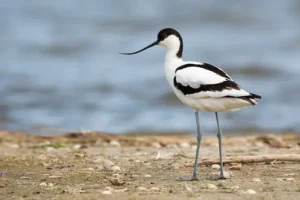
Where they are found: They are found in North America.
Beak length: The beak length of the American Avocet can vary depending on the individual bird, but on average, it ranges from approximately 3.5 to 4.5 inches (8.9 to 11.4 centimeters) in length.
Diet: They feed on a variety of aquatic insects, crustaceans (such as small shrimp and crustaceans), and other small invertebrates that live in the shallow waters of marshes, ponds, and saline or alkaline lakes.
14. Great Hornbill Birds With Long Beaks:
The Great Hornbill is easily recognized by its impressive size and distinctive appearance. It has a prominent, large, and curved bill with a casque on top. The casque is a hollow structure that appears like an extended helmet on the upper part of its bill. The casque is believed to serve multiple functions, including resonance for their calls and as a visual display during courtship.
Adult Great Hornbills are typically around 95 to 130 cm (37 to 51 inches) long, making them one of the largest hornbill species in the world.
The plumage of Great Hornbills is mostly black, with white feathers on their wings, tail, and underparts. They also have a yellow patch of bare skin around their eyes.
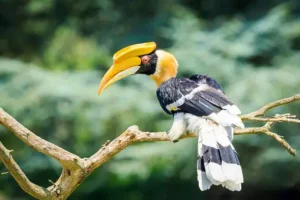
Where they are found: This bird species found in India, Nepal, Bhutan, Bangladesh, Myanmar (Burma), Thailand, Laos, Cambodia, Vietnam, Malaysia and Sumatra (Indonesia).
Beak length: The beak of a Great Hornbill can be quite impressive, measuring around 9.8 to 13 inches (25 to 33 cm) in length. The beak is curved and can be brightly colored, with a large casque on top of it.
Diet: Great Hornbills are primarily frugivorous, meaning they mainly eat fruits and berries. They have a specialized digestive system to process the fruits, often swallowing them whole and regurgitating the seeds later. In addition to fruits, they may also consume small vertebrates like insects, reptiles, birds, and small mammals.
15. Southern Yellow-Billed Hornbill (Tockus leucomelas):
The Southern Yellow-Billed Hornbill is a medium-sized bird, with an average length of about 50-60 centimeters (20-24 inches). It has striking features, including a bright yellow bill, pale yellow to white eye patches, and a black head, back, and wings.
The underparts are white, and the tail is black with white tips on the outer feathers. The legs and feet are greyish-black. Females are generally slightly smaller than males and have a smaller bill.
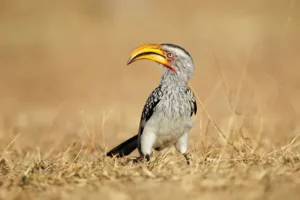
Where they are found: The Southern Yellow-Billed Hornbill, scientifically known as Tockus leucomelas, is a species of hornbill native to the southern regions of Africa. It belongs to the Bucerotidae family, which includes various species of hornbills found throughout Africa and Asia.
Beak length: The average beak length of the Southern Yellow-Billed Hornbill (Tockus leucomelas) is approximately 13 centimeters (about 5 inches).
Diet: Their diet consists of a wide range of items, including fruits, insects, small reptiles, and even small mammals. They have a specialized bill that allows them to catch and consume a variety of food items efficiently.
Must Visit: 6 Types of German Shepherd Dogs
Must Visit: How dangerous 8 effects of calicivirus
FAQ’s:
Q: What criteria were used to determine the top 15 birds with long beaks?
The selection was based on the length of the beaks relative to the bird’s body size, adaptability, feeding habits, and overall uniqueness.
Q: Are these birds from a specific geographical region or are they from all around the world?
The list includes birds from various regions across the globe. It aims to showcase the diversity of birds with long beaks found in different habitats.
Q: Can you provide some examples of birds that made it to the top 15 list?
Certainly! The list may include birds like the Sword-billed Hummingbird, Shoebill Stork, Northern Giant Petrel, Long-billed Curlew, and the Keel-billed Toucan.
Q: Are there any endangered species among the top 15 birds listed?
The list might include some birds that are classified as endangered or vulnerable. It’s essential to raise awareness about their conservation needs and the importance of protecting their habitats.
Q: Is there any information provided about the unique characteristics or behaviors of these birds?
Yes, along with the list, there should be information about each bird’s unique features, adaptations, and interesting behaviors related to their long beaks and how they use them in their daily lives.



I want to express my thanks for the engaging and compelling writing style.